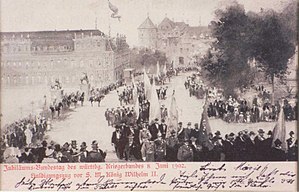Deer and Lion (Schlossplatz Stuttgart)
Deer and lion are two life-size statues that flank the entrance to the courtyard of the New Palace in Stuttgart on high granite pedestals . The two heraldic animals of Württemberg were designed and modeled by the Stuttgart court sculptor Antonio Isopi , cast in iron in the Wasseralfingen ironworks and erected in 1823.
location
The square courtyard of the New Palace extends over a width of 90 meters between the two side wings of the building. Heavy iron chains block the courtyard from the palace square. The chains are embedded in six low stone blocks on both sides of the courtyard entrance, the slender candelabra serve as a base.
Emergence
After the elevation of Württemberg to kingdom in 1806, King Friedrich commissioned his court sculptor Antonio Isopi to create life-size statues of the Württemberg heraldic animals deer and lion. The large sculptures were to be cast in iron in the royal ironworks in Wasseralfingen . But this first monumental iron casting in Württemberg was preparing major technical problems, so the cast in one piece hollow figures until 1819, three years after Frederick's death, his successor King William I were completed.
In search of a suitable location for the heavy heraldic animals (deer and lion weighed 47 and 72 quintals, respectively), King Wilhelm I decided in 1822 to replace the figures of children carrying lanterns at the entrance to the castle courtyard with statues of the heraldic animals. (For the casting of the figures see: Antonio Isopi # Wasseralfingen: Hirsch und Löwe, first monumental iron casting in Württemberg .)
Pedestals
The 8-meter-wide entrance to the courtyard is flanked by two mighty, 4-meter-high and 3-meter-wide pedestals made of yellow-red Black Forest granite, which were built in 1823 according to the design of the Württemberg court architect Giovanni Salucci . The cuboid, masonry pedestals bear richly decorated trophies on the front , each consisting of a round shield, two crossed swords with scabbard and a battle ax with a bundle of rods .
The installation of the two statues turned out to be a Swabian trick: they were mistakenly placed parallel to each other with their heads facing the palace square. When walking through the entrance, the visitor saw the back of the animal carcasses, in particular the front of the shields with the royal coat of arms remained hidden from him. It was only on the 100th anniversary of the Kingdom of Württemberg in 1905 that King Wilhelm II had this error corrected and the statues set up against one another as a “pyramidal group” as originally intended.
Deer and lion
The pedestals are crowned by the two-meter-high and long statues of the heraldic animals, which act as shield holders and face each other in a leaping position. The mighty, powerful lion and the stag, a proud twelve-pointer, are worthy representatives of the royal ruler who commissioned them. Both animals support themselves with their belly on the trophy of an armor torso and with one hind leg on a helmet. With one foreleg they hold an oval coat of arms, which shows the Württemberg coat of arms with the three stag poles and the three lions on the front and a border ornament made of oak branches on the back.
With its mouth wide open, the lion seems to respond to the rutting cry of its counterpart with a powerful roar. The compact, strong bodies show no continuous coat hair, but in the lion a powerful curly mane and also curly abdominal hair, and in the deer a curly chest fur. Together with the trophy and helmet, each of the two animals forms an ensemble connected by a rectangular base plate, which is painted in gray bronze.
|
|
|
|
| → Historical photos |
|
|
Lion gate
The entrance to the Rosenstein Park on the Pragsattel was closed in 1858 with a triumphal arch-like gate (illustration: see Rosenstein Park ). The gate was crowned with a zinc cast of the Isopi lion from the New Palace, which faces the park with the Württemberg coat of arms. In 1992 the zinc figure, which was in a desolate state, was replaced by a bronze copy. The gate bears the name Rosenstein in gilded letters, but was called the Lion Gate after its imposing crown.
literature
- Frank Ackermann: The "Ferdamten": Deer and lion: the heraldic animals in front of the New Palace. In: Schwäbische Heimat, year 61, 2010, issue 4, pages 447–450.
- Karl Büchele: Stuttgart and its surroundings for locals and foreigners. Stuttgart 1858, page 23, pdf .
- Annette Köger: Antonio Isopi: A Roman-Swabian court sculptor. In: Christian von Holst (editor): Swabian classicism between ideal and reality, essays. Stuttgart 1993, pages 131-141, here: 136-139.
- Annette Köger: Antonio Isopi (1758 - 1833): a Roman sculptor at the Württemberg court. Volume 1: Life and Work, Documents. Frankfurt am Main: Lang, 1996, pages 235-259.
- Annette Köger: Antonio Isopi (1758 - 1833): a Roman sculptor at the Württemberg court. Volume 2: Catalog. Frankfurt am Main: Lang, 1996, catalog numbers: 252–253, illustrations: 60–70.
- Karl Julius Weber : Germany, or letters from a German traveling in Germany, volume 1. Stuttgart: Franckh, 1826, pages 183-184, pdf .
Web links
Footnotes
- ↑ # Köger 1993 , pp. 136-137, # Köger 1996.1 , # Weber 1826 .
- ↑ # Köger 1996.1 , page 250.
- ↑ One of the two swords on the trophy of the lion's pedestal is missing the handle.
- ↑ # Köger 1993 , page 137, 139.
- ↑ # Köger 1993 , page 138.
- ↑ # Köger 1996.1 , pages 255-257.
Coordinates: 48 ° 46 ′ 42 " N , 9 ° 10 ′ 50.7" E









